Rebecca Ashton charts the amazing development of dressage in New Zealand
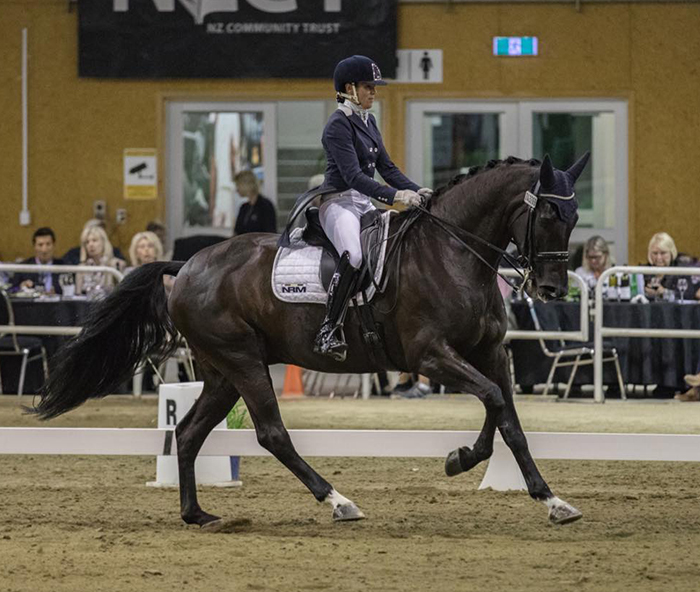
The one who made it happen!
Vanessa Way and her 2019 New Zealand Grand Prix Champion, NRM Andreas
photo credit – Caitlin Benzie
Your favourite editor Christopher Hector has been heard on more than one occasion saying that Germany will never have a great cricket team. Different countries just seem to have a better disposition to certain sports. So, perhaps New Zealand won’t be picking up any dressage Olympic gold medals in the near future, but things certainly seem to be changing, and as is so often the case in the sport of dressage, the change seems to be coming about as the result of one extraordinary trainer, a sort of Kiwi Otto Lörke. (Though much prettier – CH).
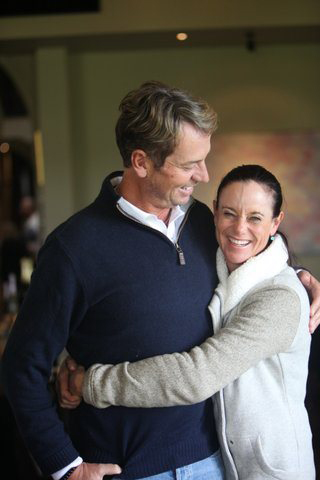
Vanessa and her mentor – Carl Hester
We shouldn’t be totally surprised to find the Kiwis starring in an equestrian sport, they have shown their capacity for amazing the world in eventing: 1990 and 1994 team gold at the World Equestrian Games, and Mark Todd and Blyth Tait have successfully claimed individual Olympic golds, but eventing is probably more in line with the country’s tradition of jumping and hunting out on rough country, over wire fences. Dressage is a very different kettle of fish, or as the locals would have it, fush.
However the back-to-back CDIs at Willinga Park in February proved just how exciting New Zealand dressage has become. While there’s always been one or two Kiwis giving their Aussie counterparts a run for their money, it’s now clear to see that there’s a real depth to the discipline that we perhaps haven’t seen before. And although they may not reach the heady heights of Todd, Jeffris, Tait, Nicholson and the Prices, there has been a noticeable turnaround that means more Kiwis are coming over and giving the Aussies a real run for their money. And that’s something.
I wanted to investigate the reasons this little non-dressage country was creeping up the scoreboard. Arguably one of the biggest influences is Vanessa Way. Talk to anyone in New Zealand about why they think they’re going places and the petite and driven Hester protegé will always be mentioned. Where Dr Bechtolscheimer and then Carl Hester changed the face of British dressage, you could argue that Vanessa is doing the same to the New Zealand scene.
story continues below the advertisement
Vanessa Way is one of the most determined people you’ll meet. That determination took her to Carl Hester’s yard in the UK for a year and after that, for the last ten years, she’s been a regular visitor. This drive for knowledge, to be better and to share what she’s learnt is possibly the single biggest boost to Kiwi dressage in recent times. So, how has Vanessa seen New Zealand dressage change over the last few years?
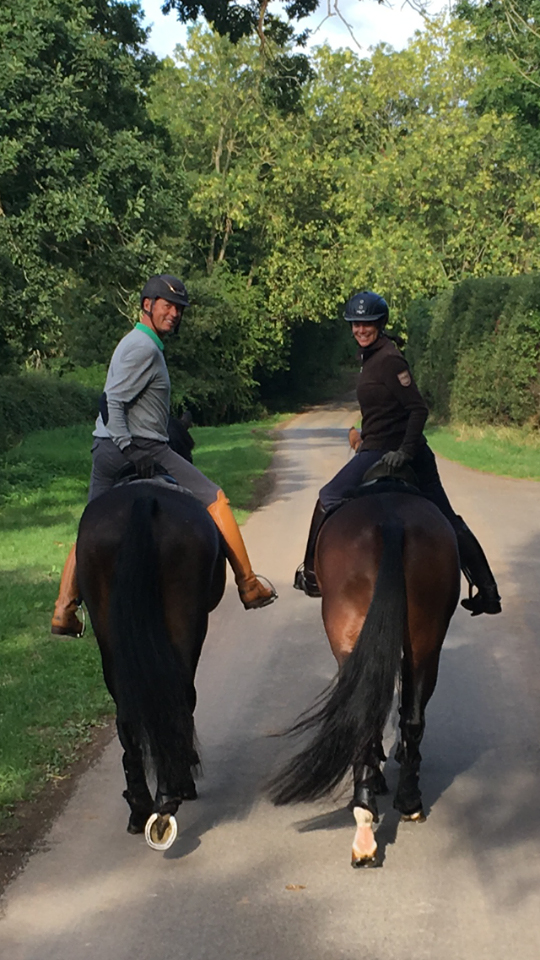 That’s a pretty handy pair of hacks, Vanessa riding Freestyle, Carl on Delicato…
That’s a pretty handy pair of hacks, Vanessa riding Freestyle, Carl on Delicato…
“I think there’s more clarity. We used to kick and hold and push the horse into the hand causing so much confusion for the horse and I think we had confusion over collection and engagement. At Carl’s we would speed the horses up a lot in working gaits, then slow down and make them bigger and smaller. We use more modern exercises like that. For example, with the piaffe, we travel it first. Before we were always taught to do it on the spot. Travel it forward 20m if you have to, make the horse reactive within the piaffe. So yes, I think now we have more clarity to the Grand Prix.”
“We work with no conflict. It’s not a problem if the horse is wrong as long as it gives an answer. A lot of my horses are sharp. My client Gaylene Lennard’s horse is really quirky. I get the lunatics! You totally need them though down the track. I’ve now got two that David Woolley bred; a four year old and five year old. Really hot. I mean I’m 50 now. What am I thinking?! But hotter horses come with more reaction. Reactions need to be dealt with clarity. It’s knowing what to do with them. I got to work all of Carl’s young, quirky ones which gives you a whole new skill set! Before that I had had naughty but hadn’t had heat. You learn things the hard way!”
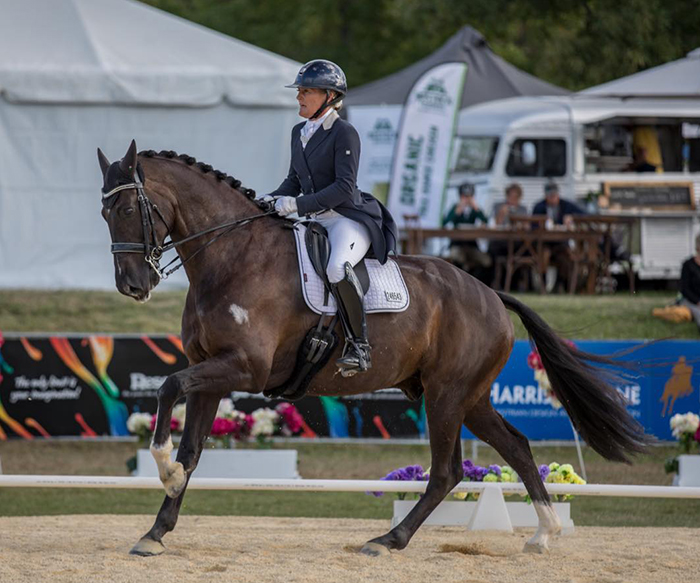
Gaylene and her ‘lunatic’ Jax Johnson: Photo: Caitlin Benzie Photography
“I also have really loyal clients like Melissa Galloway and Gaylene who have stuck with me for a long time. I’m lucky to have pupils that believe in me. I also sit on the horses a bit. I’ve sat on Melissa’s a lot. Being a rider, I think that helps a lot. I just love training horses and riders.”
“In New Zealand I think we find a way. I don’t believe in can’t, especially now with internet access. We have that attitude that we can. I used to think I looked retarded when I went and competed in Australia all those years ago, but now I feel proud and proud of my country. I was dreadful but I worked hard and learnt a lot. I’m really positive to keep helping New Zealand. There are no dramas here. We all get on. I think we’re really lucky because we don’t have the politics you can sometimes get. We back each other and the judges support us and want us to get better.”
story continues below the advertisement
Vivaldi, available in Australia from www.ihb.com.au
“David Woolley’s a freak. He’s bred six international horses. Cooper Oborn has one, I have two, Gaylene has another and then there’s Melissa’s two. Although, I think you have to be a certain rider for them. I think it’s exciting what he’s doing and he’s doing it at affordable prices for us. It’s more important for him that they are with good riders rather than the person with the most money. He was a rider himself and it’s his passion. He loves going to the shows and following us all. He really follows us the whole way. You have that extra person behind you. It’s really lovely.”
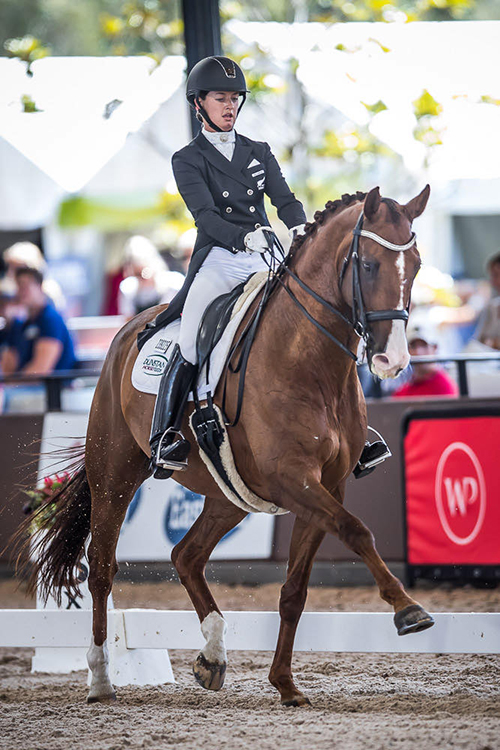 Melissa Galloway competing at Willinga on Windermere J’Obei W
Melissa Galloway competing at Willinga on Windermere J’Obei W
(Photo – Stephen Mowbray)
THE RIDER
One of Vanessa’s students, Melissa Galloway, lives in Marlborough, which is just at the top of the south island and is about as remote as you can get. Having won every Grand Prix test she’s entered in New Zealand with her gelding Windermere J’Obei W, Melissa really made us all stand up and notice during the two Willinga Park CDIs. The 27 year old and her nine year old Johnson gelding, were only beaten by Mary Hanna in all six tests over the course of the two competitions. The combination scored well over 70% in four of the tests and Melissa thinks the gelding still has plenty of marks in him. The pair then went on to win New Zealand Horse of the Year to end the season. I sat down and chatted with Melissa at Willinga.
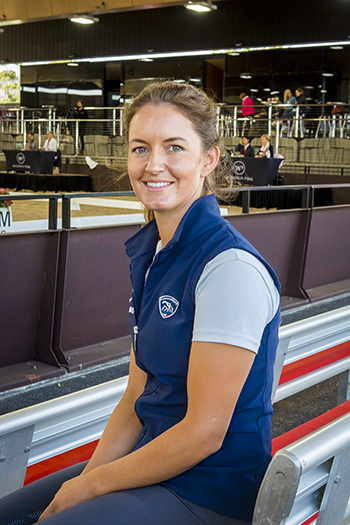
Mellissa Galloway (Photo – Rebecca Ashton)
“My Mum used to do hunting and show jumping and then when she had us, she stopped and just did hacking and trail riding. My sister and I used to hang out the window begging for a ride. She got my older brother into Pony Club but he wasn’t that interested so she never pushed me or my sister. That’s always the way, we weren’t pushed so we were desperate to ride. I had a little miniature and then ended up with a really big pony when I was tiny.”
“I then got Kirkwood Annabel which was more of a show pony and showjumper. I got her when she was six years old and I did a bit of everything with her. I started a bit of dressage at the local shows and she happened to be quite good at it so it went from there. When I won my first title at the Young Rider Championships at level 2, that’s when I thought, I really want to do this. I love it.”
“In 2006 at WEG, Andreas Helgstrand did that freestyle with Blue Hors Matine, back when we had dial up internet. Someone from our local dressage group sent it to my parents via email and it took about two days to download. When it finally downloaded I watched it and watched it and watched it. I think I was about 13. I had goosebumps. It was my dream to do that.”
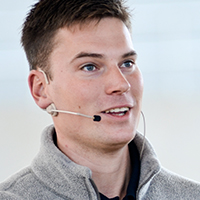
Hubertus Hufendiek
“When I was 13 I started training with Andrea Raves who migrated to New Zealand from Germany. Andrea and a friend of ours helped me get a job with Hubertus Hufendiek in Germany when I was 18. I had had some lessons with him in New Zealand when he was the national coach and I did very badly in those lessons. I was so nervous! I begged him to take me back to Germany and I was only supposed to be there for two weeks. I rode the not so great horses but worked really hard and then eventually I rode all the horses. I ended up staying a year and competing three horses up to S level. I had never ridden above Level 4 before that. I probably wasn’t the best rider technically. I had to learn a lot, work on my position but he said I did have a good natural feel for the horses. I was able to teach the horses collection and swinging trot easily. I credit him for the basis of my training.”
“For the past six years I’ve been training with both Andrea and Vanessa Way. Vanessa has really taken me and Joey to the next level and taught me all the Grand Prix and helped me teach my horse. She’s been very supportive and she really believes in us.”
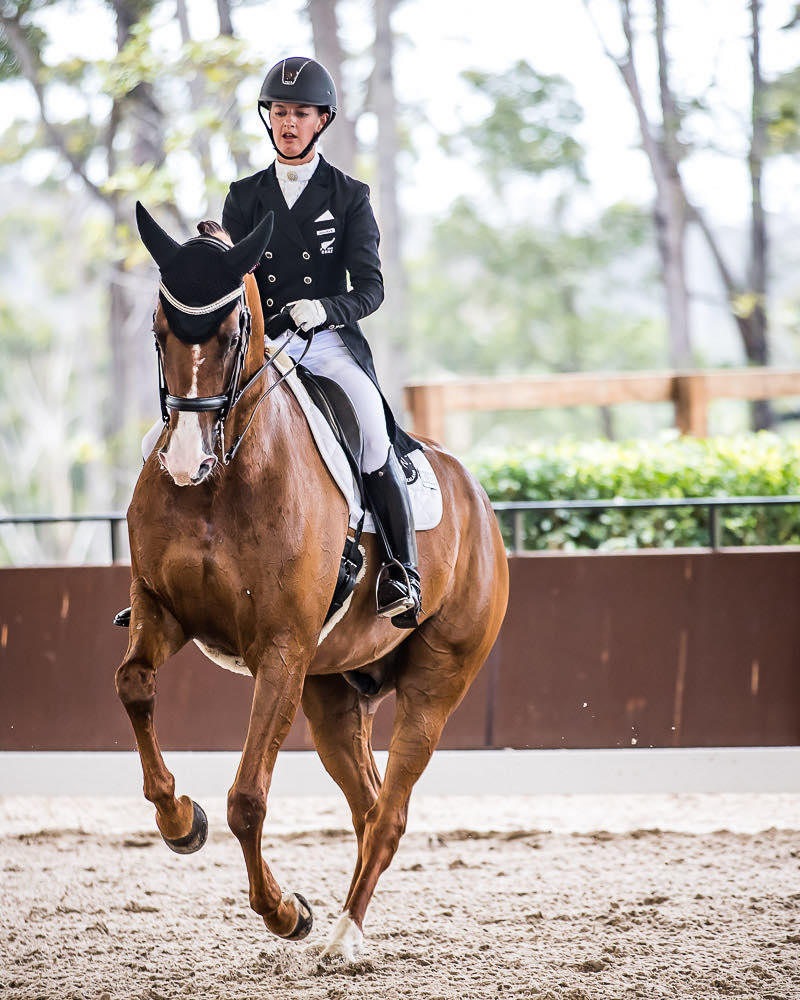
Joey – the good one (Photo Stephen Mowbray)
“I got Joey when he was 18 months old. He’s nine now. I bought him off David Woolley. I also bought his half brother at the same time. He’s two years older than Joey and probably not as talented but he’s really consolidated at Grand Prix now. He was particularly difficult. He was the first horse in Australasia by Johnson. He didn’t get a very good reputation because he bucked and had to go to three breakers. He bucked me off six times in the first six months. He was very difficult.”
Editor’s note: Readers may remember that in my report on the recent Dutch Stallion Licensing, I quoted one of The Netherland’s leading riders from one of the top stables, who said that they had a policy of No Johnson in their stables, not even horses out of Johnson mares, because they had had such bad, frightening experiences with Johnsons. Those Kiwi girls are made of sterner stuff…
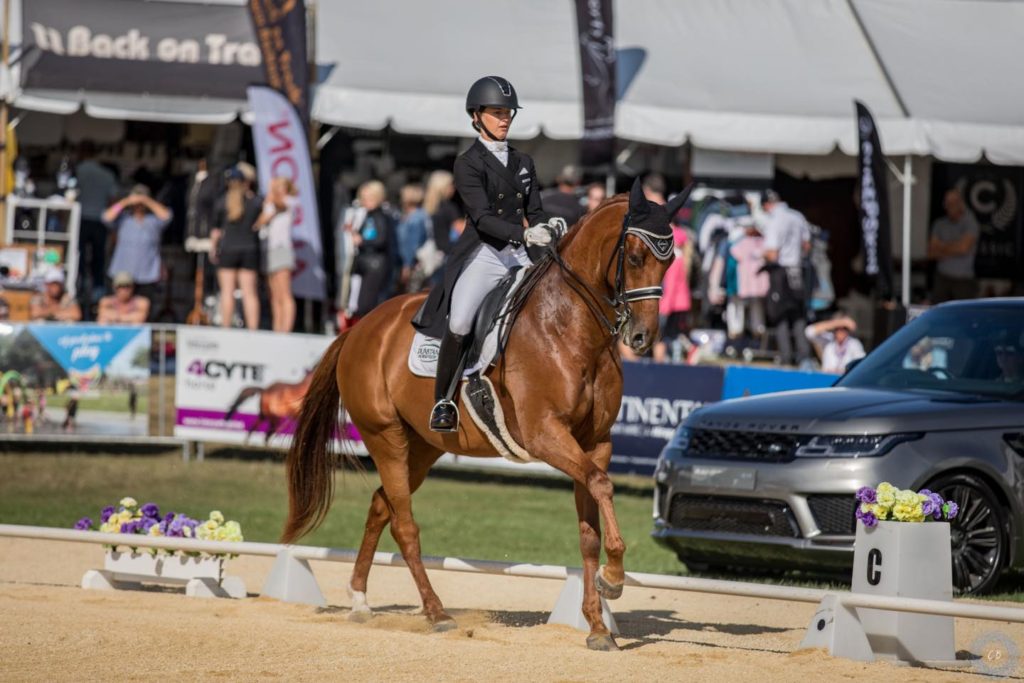
Johnny – the ‘bad’ one… Caitlin Benzie Photography
“When I was in Germany I rode a horse by Johnson and I fell in love with that horse so when I came back home, I saw these two horses on Trade Me. They’d been on sale for over a year and had been offered to some of our top riders and no one wanted them. I was just this random girl who called up. I don’t think they thought I was the right rider for them. I saw Joey loose in the paddock and it was actually his canter that stood out to me. It was so loose and uphill. We wanted Joey and weren’t sure about Johnny but they came as a package! So, we got them both. Everyone told us we were crazy to buy the older one and I did fall off him a lot, but once he got to Level 4, he just calmed down and enjoyed the harder work and now he just got 68% at Grand Prix.”
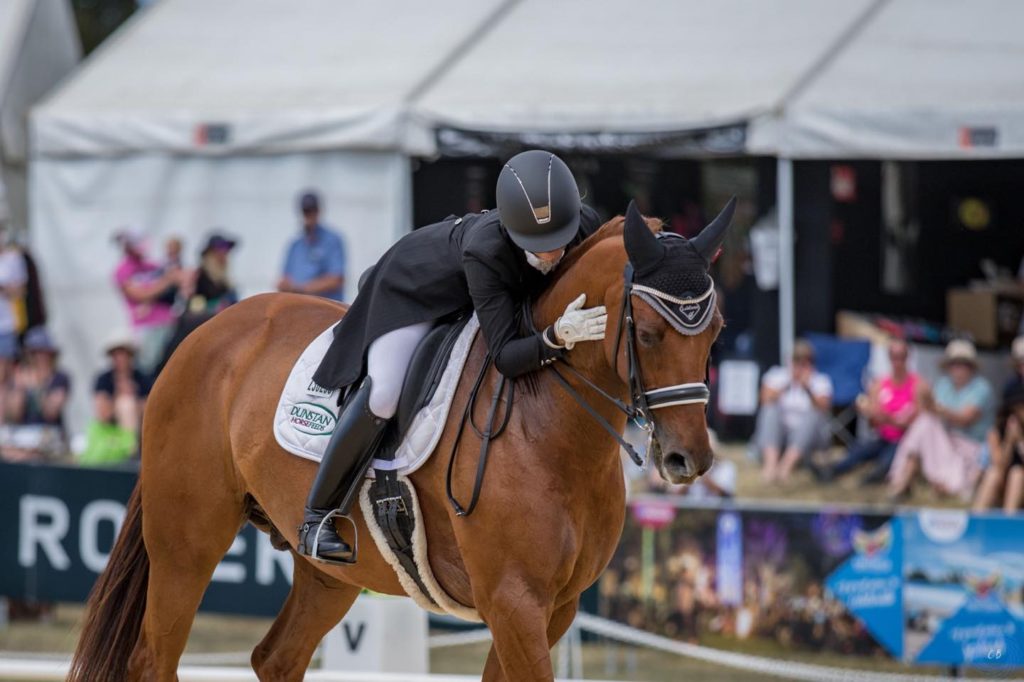 Now he’s good too! Caitlin Benzie Photography
Now he’s good too! Caitlin Benzie Photography
And why does Melissa think New Zealand dressage has reached a new level? “I don’t know. Maybe it’s just that Kiwi determination. I think Vanessa Way has been a massive influence. I think she’s helped so many horses and riders be better than they thought they could ever be. There are some horses coming through now like Gaylene’s who is also a Johnson bred by David. That’s going to be a top, top Grand Prix horse. They’re scoring 74% in the small tour at the moment. It’s got amazing piaffe. Vanessa is coaching her too. Vanessa is a very special coach; her ability to see and she’s so quick. She can see things and she knows how to sort it out having ridden lots of different horses with lots of different problems. She’s still riding now and can relate to everything.”
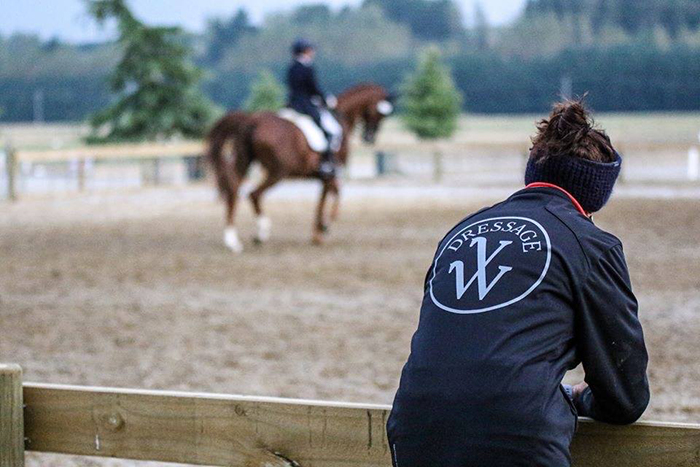
“Obviously her help from Carl has been huge and she’s taken our sport to another level. She wants us all to be better than herself. I don’t see her as much as I’d like. She comes to Blenheim about once every two months. In between I send her videos. Even from here at Willinga she’s been helping me with my training and watching my tests online. I’ve definitely had to learn how to be ok on my own though. Like here I don’t have anyone to help me or warm me up. I’ve just done it myself. I have to be able to do that. It’s been amazing to have the mirrors in the warmup arena here! It’s awesome. I wish we had that at every show!”
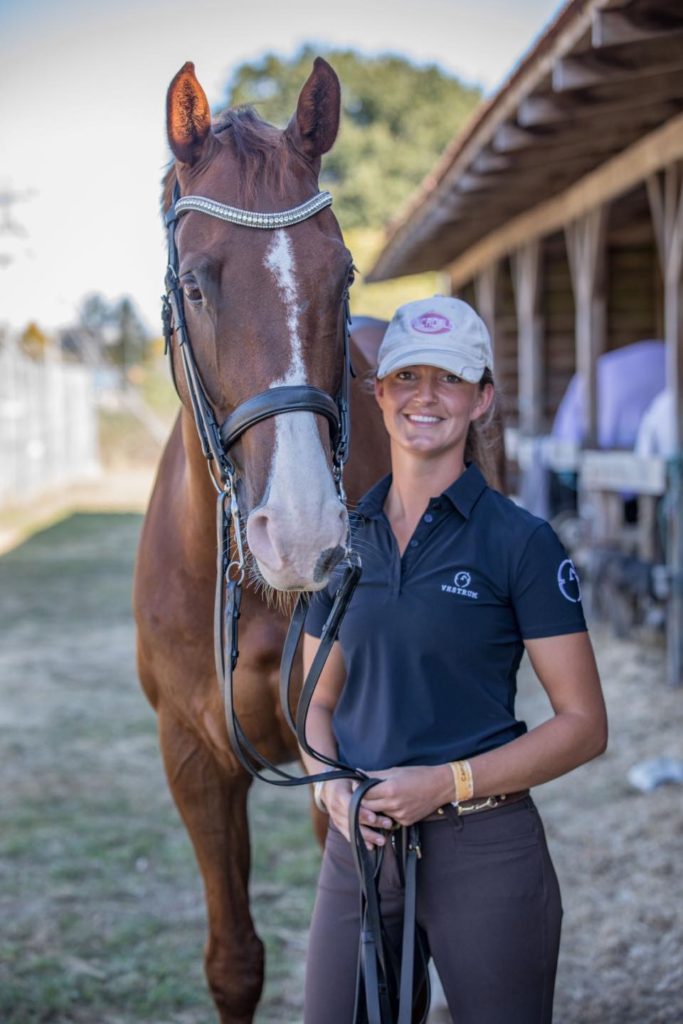
Photo credit: Caitlin Benzie
“You just have to be really determined and want to be better and better all the time. Every test I come out of, I’m happy but I just want to be better. I spend a lot of time watching riders like Charlotte online at night. I love it. I’m a real visual learner. It’s interesting when I was in Germany, Hubertus said it was a good thing that I had learned to ride independently. The riders in Germany are always told what to do so then when they’re on their own, they don’t know what to do.”
story continues below the advertisement
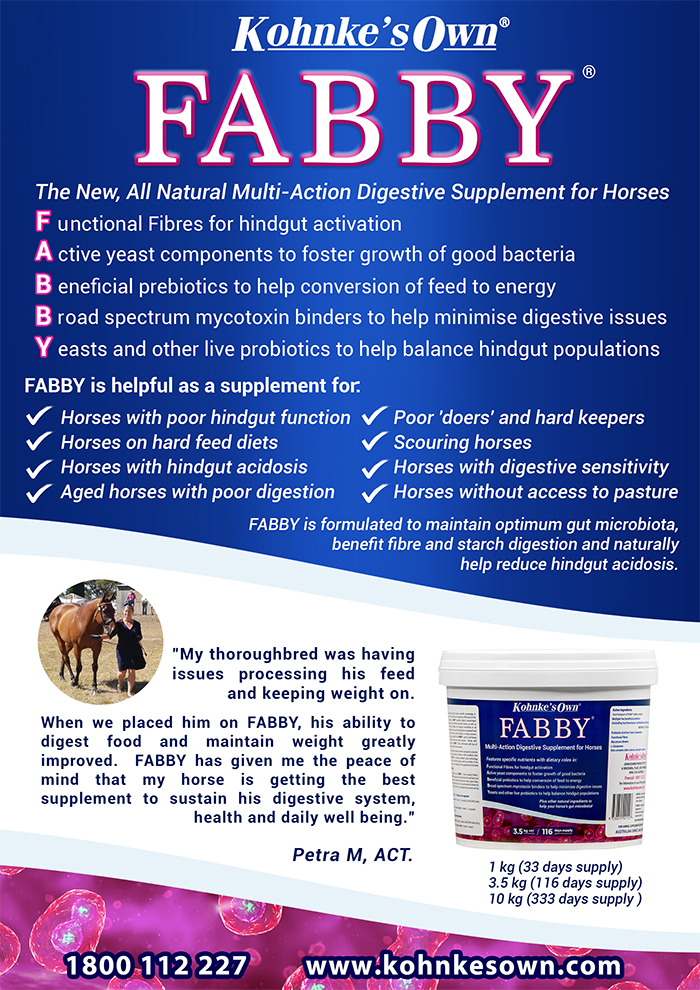
“The biggest thing I learnt in Germany though was the quality of the paces. Teaching the horse to improve the gaits; swing in the trot, improve the canter before we did any of the tricks. That’s all we worked on along with position and seat. The seat is so huge. The work has to be quality work. Lots of expression. I think that’s very important. I wrote a diary while I was in Germany and I think everyday I wrote inside leg, outside rein, sit deeper. Everyday was the same thing. It sounds boring but you have to get it in your head, you have to nail it.
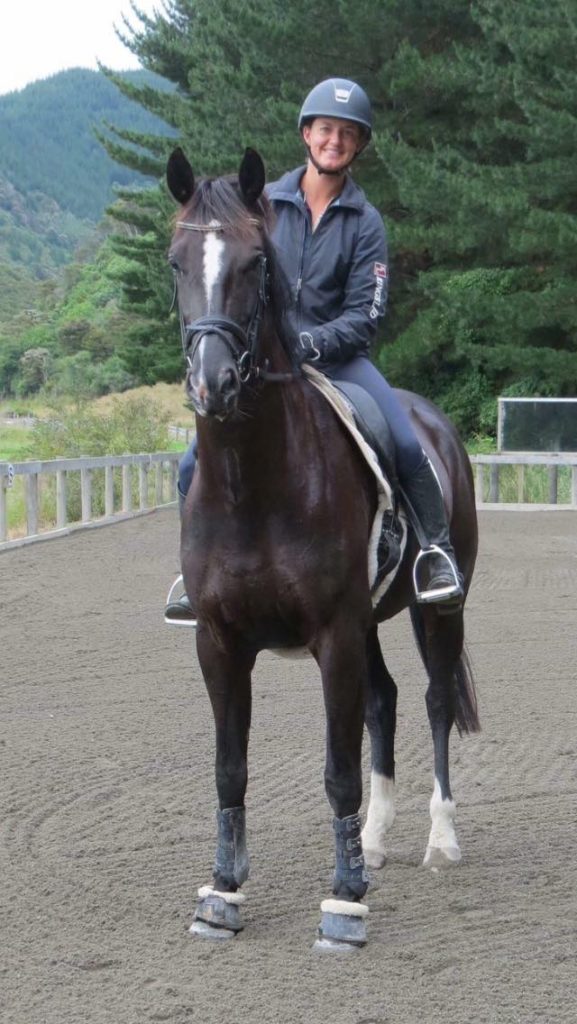 Melissa’s Negro – Elmo aka Windermere Integro
Melissa’s Negro – Elmo aka Windermere Integro
“I ride full time. We breed a little bit. I have a five year old by Negro. He looks a lot like Valegro, but we can’t put that pressure on him! I teach and do clinics, but my love is really the riding. I’m riding five horses at the moment with two more coming from the breakers. My sister rides too but more the jumpers. But we work together and she’s kind of my groom. A lot more people seem to import horses in Australia whereas riders in New Zealand tend to ride home breds. That’s the biggest difference I see. I think it’s something that’s very special, riding the horses bred in New Zealand and also having them from when they’re really young. That’s something I’m very proud of, training my own.”
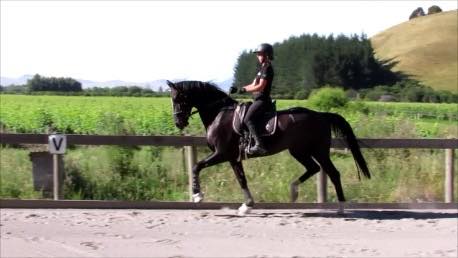
THE BREEDER

David Woolley
PHOTO CREDIT: Hannah Comrie from NZ SuperGroom and Photographer
David Woolley, although only a small breeder has proved he’s got quite the eye and has placed many horses with New Zealand’s top riders. I asked David how he’s gone about his breeding and why he thinks New Zealand is starting to get some depth to the dressage sport.
“In Australia it seems a lot of the top team riders are based overseas and there’s enough money that the top horses come from overseas. It’s more of a foreign based sport at the top level than it is here in New Zealand. There’s probably less money in New Zealand. I think we’ve been lucky to have Andrea Raves here for a long time as a trainer and she’s provided a fabulous base. Judith Matthews has used frozen semen and has been breeding some really good horses for a long time as well.”
“During his Masterclass last year, Carl Hester was so surprised with the horses. And it’s not just the quality, but also because Vanessa has played a big part in their training. She has had that exposure to Carl and can train them in that really modern way that makes it look easy. I actually saw a comment from Mary Hanna about Melissa, that she rides in a really modern way. And it is compared to what you’ve seen in the past in Australia and New Zealand. Melissa has three horses that I bred. Two Grand Prix ones, both by Johnson out of Thoroughbred mares, Joey and Johnny and a two year old by Johnson. Johnny was a little nut case. We wouldn’t let her take Joey without taking the other one! He was a very touchy horse since the day he was born. He’s doing so well at Grand Prix as well. I think Joey is the superstar though. He can passage as well as any horse out there. Carl said that horse is as good as it gets. I have half sisters to both of Melissa’s Grand Prix horses and a half sister to the Gaylene’s horse. They’re my broodmares.”
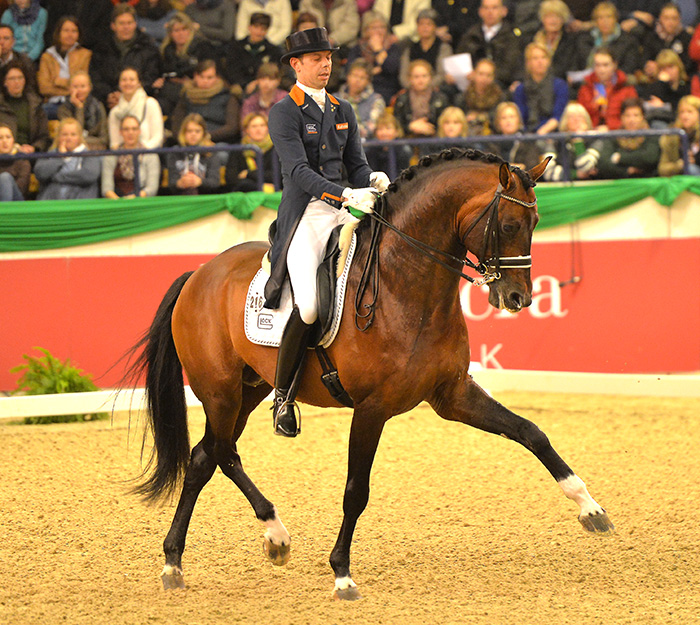
Johnson – ‘amazing!’
“I saw Johnson by chance watching a video of him one day while I was bored at work. I saw him in his licensing in hand and he just looked amazing. We investigated whether we could get the semen in New Zealand. We watched him as a young horse and then a few years you didn’t see him and then he came out Grand Prix and was a team horse for Holland. Early on people in Europe were saying how they didn’t like him but then he started doing well and his progeny started doing well. I happened to breed to Johnson and have three Grand Prix horses from the first three horses I bred. It’s the best decision I ever made. I have another Johnson foal and two four year olds, one of which I sold to Vanessa.”
“I used the Thoroughbred mares. We went and bought two racehorses. One was on Trade Me and the other one was from the sales. Joey’s mother cost us $300. She looked exactly like him, huge, chestnut, big neck, really strong top line, bent through the joints well when she moved. She was an elite mare when she got approved by the Hanoverian Society. We were given the mother of Gaylene’s horse.”
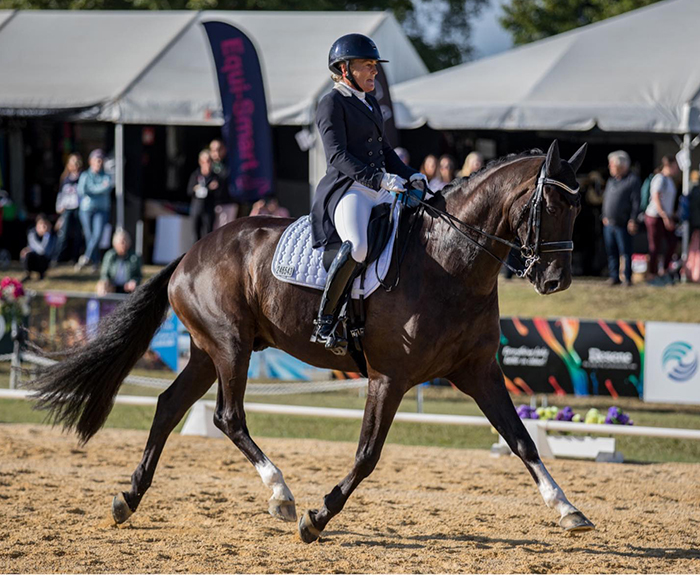
Gaylene and Jax – another Johnson: Photo: Caitlin Benzie Photography
“I read an article in The Horse Magazine that Chris wrote about the latest rankings of the best dressage stallions. There were some really interesting graphs in there. There was one of the Thoroughbred blood in the top ten stallions. Vivaldi, Jazz, Johnson had 40-44% thoroughbred blood in them. So Joey, who has Johnson as a father with that much Thoroughbred in him out of a Thoroughbred mare, that’s a lot of blood!”
“The other interesting graph was a strike rate percentage of the top ten stallions that get to Prix St Georges then Grand Prix. Johnson was about second on the list. That’s not bad for such a young stallion. That told me that I need to keep the blood in the horses really high. I think it makes it a lot easier at Grand Prix as well. Mary Hanna’s Calanta is also by Johnson. John’s horse is out of a Johnson mare. So at Willinga it was Johnson, Johnson, Johnson mare in the top three.”
“In between I’ve done a few German horses and they’ve been pretty good. Most of those horses are now my brood mares. This year I have six in foal. The stallions I use have to have been a Grand Prix horse or have left a Grand Prix horse for me to use them. They have to come from a Grand Prix line. I don’t necessarily want to breed a beautiful, black spider by an unproven stallion. I’ve used Zonik. I love Zack. I think he’s quite phenomenal. I think Jazz has the strongest genes of any stallion. I love Don Schufro and the Sir Donnerhall mares; they just keep coming up time and time again.”
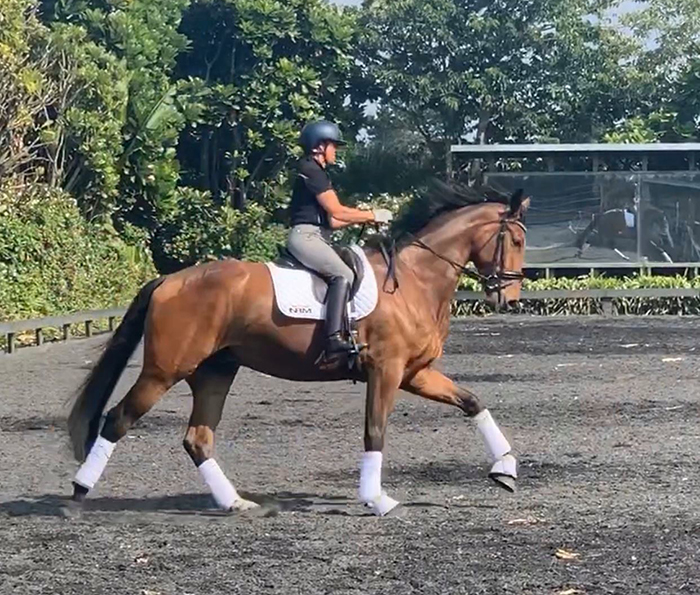
Vanessa’s Fürst Romancier – DW Furst Rock
“Now I always try to sell my horses to really good people. Vanessa has been a huge coup for New Zealand with getting into Carl and knowing what she knows. I started to stalk Vanessa and showed her a video of a Füirst Romancier out of the half sister of Melissa’s older horse. He’s a freak mover and he’s now five and about to go to his first show. She really loves him. His name is DW Furst Rock. Cooper Oborn has a young Bordeaux that I bred. He also trains with Vanessa.”
THE CHAIRMAN

Scott McKenna, Chairman of Dressage NZ, sums things up: “Kallista Field came to Australia with Waikare and won (the combination also represented New Zealand at the Sydney 2000 Olympics scoring 68% in the Grand Prix Special and just missing the cut off for the kur). Then we had Julie Brougham and Vom Feinsten who was scoring in the 70s. Wendi Williamson had Deja Vu; that was a seriously good horse before he unfortunately died. Wendi’s on her second string horse now. Vanessa Way had KH Arvan scoring in the 70s in national shows before it got injured and she has another scoring in the 70s. Kallista is back with a small tour horse that is seriously talented and winning everything with really high marks. But it’s the depth we have now. We have the four combinations here (at Willinga), but there’s two or three combinations still at home who are scoring at least as high as these guys.”
Scott is quick to point out that it’s all come from hard work and some cluey coaches and home bred horses. “Not one of those riders had a fancy school master as a young rider. They’ve all been forced to find a way to do it. There’s not been one way for all of them either. There have been a few stand out coaches; Vanessa Way, Andrea Raves and Christine Weal are probably our three leading coaches. Vanessa has probably got the most riders getting the best results and that’s largely because of her training with Carl Hester. I think that’s really pushed us forward in the last couple of years.
All of the horses except John Thompson’s horse JHT Chemistry have been home bred. Victoria Wall’s horse is by a resident NZ stallion. Wendi’s horses are from Matthew’s Hanoverians. Melissa’s two Grand Prix horses were bred by David Woolley. Possibly the best small tour horse going around at the moment was also bred by David (Gaylene Lennard’s Jax Johnson).
“Michael Milton Paralympic gold medal winning skier spoke to us at the FEI Regional Dressage Forum. His point was when you take away a leg, you have to find creative ways to solve everyday problems. I think that’s a little bit like New Zealand dressage. We have a huge disadvantage to probably any other dressage country so we’ve had to find a way to succeed. Even if you had money, you couldn’t buy a trained school master. They just didn’t exist. We have had a couple of good ones imported as youngsters, but really, there’s just been a couple. So, we’ve really done it all on our own horses. Our young riders were thrown in the deep end and had to work it out. That creates a sustainable model. That makes riders who can not only last but really make horses. You can’t buy medals.”
So horses with lots of blood and matching them with top riders, spending time in the stables of the world’s top trainers, doing the hard yards and helping each other seem to be the main ingredients of success for the Kiwis. That “never say die” mentality should see the Antipodeans garner ever more success on their dressage journey.
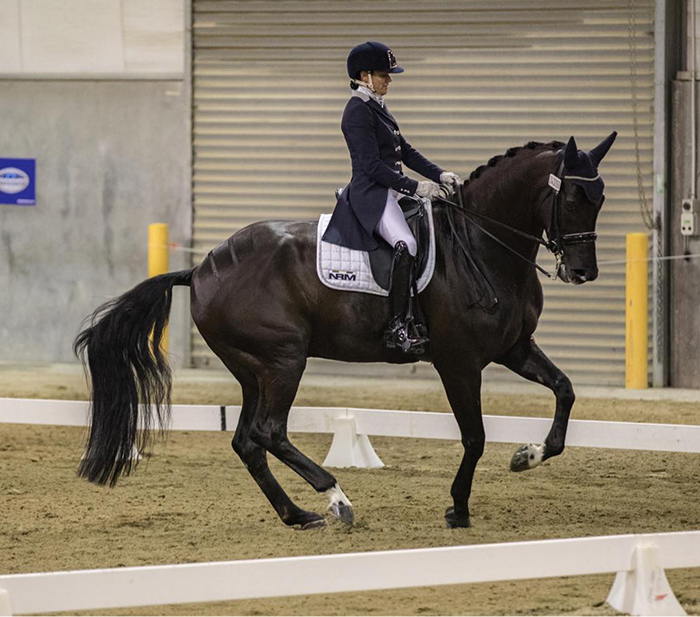
Vanessa and NRM Andreas leading the Kiwi challenge: Photo Caitlin Benzie

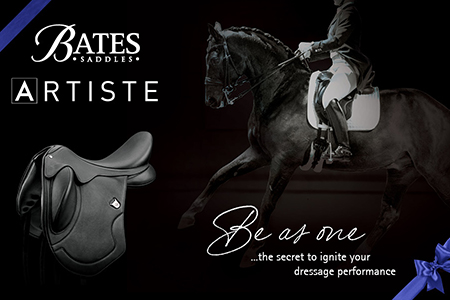
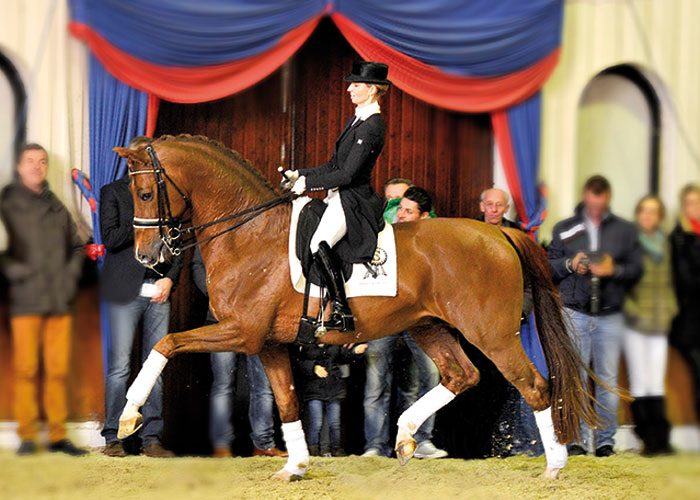
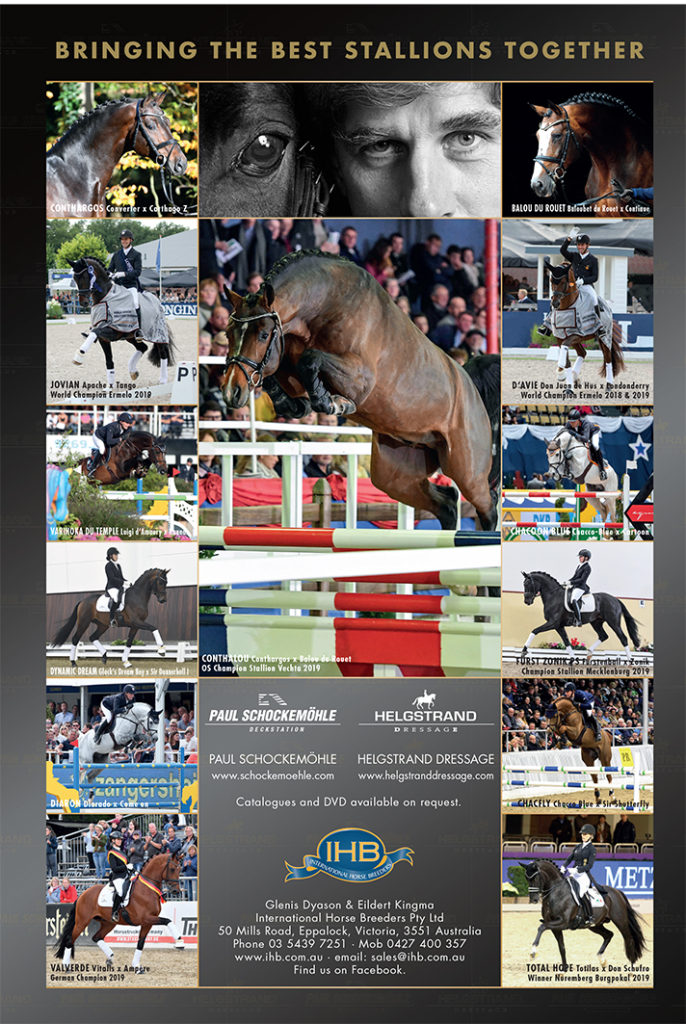
A very good read.